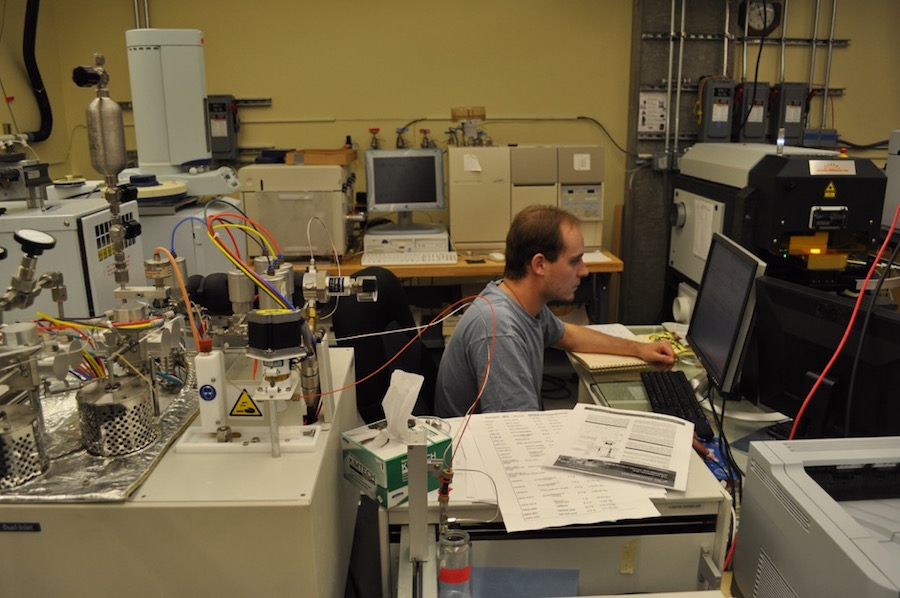
UC Davis Stable Isotope Lab houses climate reconstruction of the past
Due to recent unpredictable weather, students have to face the tough decision of whether or not to lug a jacket around campus all day in case it suddenly rains or gets cold. Surprisingly more accurate than our current everyday weather predictions are climate conditions of the past.
Scientists can determine what the climate was like in the month of August 100,000 years ago or what ocean temperatures were 30 million years ago.
These incredibly detailed reconstructions of past climate information occur at the UC Davis Stable Isotope Laboratory (SIL) in the Department of Earth and Planetary Sciences.
One research method at the SIL includes using a highly specific laser to shave off miniscule particles of a fossil material in order to analyze its composition and determine the type of environment it was in.
Daily sampling through laser analysis is used on coral because it grows so quickly. Essentially, information can be gained on what coral did on a day-to-day basis all the way back to 100,000 years ago.
“We are very interested in the ocean temperature of the arctic right now, and looking at data regarding how arctic sea ice melted over last 10,000 years and when the arctic was ice free,” said Howard Spero, professor in the Department of Earth and Planetary Sciences and the director of the SIL.
Additional research includes looking at the effects of ocean acidification in the past and present.
Inquiries into developing and calibrating new geochemical tools to reconstruct past environments also occur at this lab. Researchers seek to extract novel climate information from the geologic record.
The research lab in the Department of Earth and Planetary Sciences was founded in 1993 and will celebrate 25 years of research next year.
The goal of the lab is to have the analytic capabilities to measure carbon, oxygen, hydrogen and nitrogen isotope ratios on collected fossil material.
Through analysis of rocks and deep sea sediments, scientists are able to reconstruct the environment from when the organism was alive.
“We do a lot of research and collaborations with graduate students and researchers all over the world interested in looking at records of environmental change through changes in stable isotope geochemistry contained within skeletons, shells and minerals,” Spero said.
Types of samples that are often analyzed at the lab include: microfossils; corals; foraminifera, or sand-sized marine protists; diatoms, a type of phytoplankton; and radiolaria, tiny protozoa, or single-celled organisms.
When these organisms die, the remains and shells accumulate on the seafloor and become part of the sediment. Over time, more layers of sediment build up on top.
Scientists are able to deduce the age of sample sediments collected based on the composition and how deeply buried the layer is. A sample collected near the top of the seafloor will be younger than a sample taken at a meter into the seafloor.
“Trace amounts of other elements are incorporated into a shell when [an organism like foraminifera] grows,” said Jennifer Fehrenbacher, former post-doctorate and research scientist at the SIL via email. “The composition of the trace elements varies with growth conditions like temperature and pH. This makes them useful as ‘proxies’ for environmental conditions in the past.”
Extremely precise lasers and probes enable analysis of collected samples. Housed in this lab is an inductively coupled plasma mass spectrometer (ICPMS). This machine fires laser at a sample to ablate, or remove thin layers, of about 100 nanometers. To give some context, a dime is approximately 1 millimeter thick, and fits 1 million nanometers.
“The laser is an amazing analytical tool because it is minimally destructive so you don’t consume the entire specimen during analysis,” Fehrenbacher said via email. “That means that you can quantify the elemental composition of the specimen you are studying using the laser and the remaining part of the specimen can be analyzed using other instruments.”
The shaved off surface sample material goes into a mass spectrometer that then gives information about the stable isotopic composition.
Tessa Hill, an associate professor in the Department of Earth and Planetary Sciences and a researcher at the SIL, seeks to understand climate change impacts on the ocean in the past and present. By studying the chemistry of the shells of foraminifera, clues can be given to how the environments have changed in the past.
“In this project, we are interested in whether the chemical fingerprint of the shells (elements like Mg [Magnesium] and Ca [Calcium]) changes under particular future climate scenarios,” Hill said via email. “So, we raised foraminifera in the lab, under controlled temperature and water chemistry, and then we analyzed the shells in the Stable Isotope Lab.”
Hill, along with student researchers, utilized the ICPMS to remove a thin layer of the shell to determine its composition.
There are currently two stable isotope labs on campus which each serve a different function.
“The SIL is purely a research lab that conducts and analyzes primarily different types of calcium carbonate, silica and water samples for reconstructing climate history, as well as environmental change on earth today,” Spero said.
The second lab is a service lab, called the Stable Isotope Facility in the Plant Sciences Department. This lab accepts samples to analyze from researchers both on campus and worldwide.
Once analyzed, the lab sends the data back, and no longer takes part in that research. This facility has a far larger range of analytical capabilities with hundreds of thousands of organic and water samples cycling through.
The SIL collaborates with many institutions, and encourages graduate and undergraduate students who are able to operate instruments in the lab to collect data for their senior thesis projects.
“UC Davis gives students the opportunity to work with world-class researchers in their labs and learn techniques that will propel [their] career in the future,” Spero said. “Take advantage of this because if not, you are missing out on an incredible opportunity.”
Written by Shivani Kamal — science@theaggie.org



